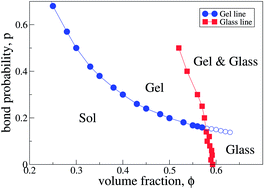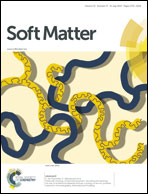Dynamical arrest: interplay of glass and gel transitions
Abstract
The structural arrest of a polymeric suspension might be driven by an increase of the cross-linker concentration, which drives the gel transition, as well as by an increase of the polymer density, which induces a glass transition. These dynamical continuous (gel) and discontinuous (glass) transitions might interfere, since the glass transition might occur within the gel phase, and the gel transition might be induced in a polymer suspension with glassy features. Here we study the interplay of these transitions by investigating via event-driven molecular dynamics simulation the relaxation dynamics of a polymeric suspension as a function of the cross-linker concentration and the monomer volume fraction. We show that the slow dynamics within the gel phase is characterized by a long sub-diffusive regime, which is due both to the crowding as well as to the presence of a percolating cluster. In this regime, the transition of structural arrest is found to occur either along the gel or along the glass line, depending on the length scale at which the dynamics is probed. Where the two lines meet there is no apparent sign of higher order dynamical singularity. Logarithmic behavior typical of A3 singularity appears inside the gel phase along the glass transition line. These findings seem to be related to the results of the mode coupling theory for the F13 schematic model.


 Please wait while we load your content...
Please wait while we load your content...